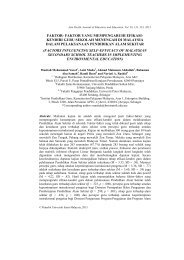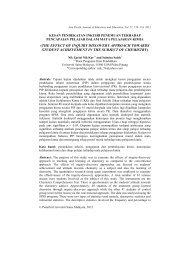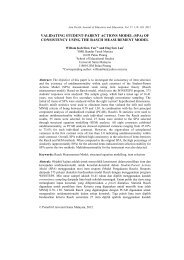Full Text - Asia Pacific Journal of Educators and Education
Full Text - Asia Pacific Journal of Educators and Education
Full Text - Asia Pacific Journal of Educators and Education
- No tags were found...
Create successful ePaper yourself
Turn your PDF publications into a flip-book with our unique Google optimized e-Paper software.
Mohd Hanafi Mohd Yasin et al.KESIMPULANSecara keseluruhannya, hasil kajian menunjukkan bahawa kebanyakan guruberpendapat bahawa infrastruktur bilik darjah pendidikan khas di sekolah perludinaik taraf dan diberi perhatian kerana rata-rata daripada pelajar pendidikan khasterpaksa belajar di dalam bilik darjah yang sempit dan kekurangan kemudahan.Penyediaan peluang-peluang pengajaran dan pembelajaran yang sama rata perludiadakan termasuk untuk pelajar berkeperluan khas bagi membolehkan merekaberdikari dan memperkembangkan potensi masing-masing. Bilik darjah jugasepatutnya tidak perlu diasingkan berjauhan dengan bilik darjah pelajar normalkerana pergaulan di antara mereka akan terbatas dan pengasingan ini juga akanmenjejaskan keyakinan dan kepercayaan diri pelajar-pelajar berkeperluan khas.Selain itu, pengurusan bilik darjah yang dinamik bergantung kepadakebijaksanaan guru memainkan peranan sebaik mungkin bagi menghasilkan bilikdarjah yang harmonis, kondusif dan perlaksanaan pengajaran dan pembelajaranyang memberangsangkan.RUJUKANCampbell, P. H., Milbourne, S., Dugan, L. M., & Wilcox, M. J. (2006). A review <strong>of</strong>evidence on practices for teaching young children to use assistive technologydevices. Topics in Early Childhood Special <strong>Education</strong>, 26(1), 3–13.Elder-Hinshaw, R., Manset-Williamson, G., Nelson, J. M., & Dunn, M. W. (2006).Engaging older students with reading disabilities: Multimedia inquiry projectssupported by reading assistive technology. Teaching Exceptional Children.39(1), 6–11.Eleweke, C. J. (2002). A review <strong>of</strong> issues in deaf education under Nigeria's 6-3-3-4<strong>Education</strong> System. <strong>Journal</strong> <strong>of</strong> Deaf Studies <strong>and</strong> Deaf <strong>Education</strong>, 7(1) , 74–82.Elliot, J. L., & Thurlow, M. L. (2006). Improving test performance <strong>of</strong> students withdisabilities: On district <strong>and</strong> state assessments (2nd ed.). Thous<strong>and</strong> Oaks, CA:Corwin Press.Goldsmith, J., & Goldsmith, L. (1998). Physical management. In Lacey, P. (Ed.), Peoplewith pr<strong>of</strong>ound <strong>and</strong> multiple learning disabilities: A collaborative approach tomeeting complex needs (pp. 15–28). London: David Fulton Publishers.O'Connor, L., & Schery, T. (1986). A comparison <strong>of</strong> microcomputer-aided <strong>and</strong> traditionallanguage therapy for developing communication skills in non-oral toddlers. The<strong>Journal</strong> <strong>of</strong> Speech <strong>and</strong> Hearing Disorders, 51, 356–361.8







